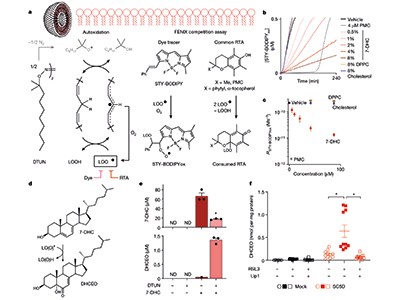
Read the paper: 7-Dehydrocholesterol is an endogenous suppressor of ferroptosis
Biology remains nothing short of astonishing, as researchers unveil the underpinnings of its myriad systems, especially those that are involved in protecting against cell death. Writing in Nature, Freitas et al. and Li et al. shed light on a regulated form of cell death called ferroptosis, which is driven by an iron-dependent modification of lipids in cellular membranes. The results bring into sharp focus an unexpected hero, the molecule 7-dehydrocholesterol (7-DHC).

Read the paper: 7-Dehydrocholesterol is an endogenous suppressor of ferroptosis
The term ferroptosis was coined in 2012. This cell death encompasses a variety of processes that include lipid oxidation by the action of reactive molecules called radicals (versions of molecules that have an unpaired electron) and the fragmentation of lipids at cellular membranes, culminating in membrane disruption, shrunken mitochondrial organelles and swelling of cells (‘ballooning’). Ferroptosis occurs when there are problems in the regulation of normal iron levels (iron homeostasis) and in the oxidation of lipids. Preventing ferroptosis might be beneficial in alleviating neurodegenerative and kidney diseases, and activation of ferroptosis can kill cancer cells.
Freitas et al. and Li et al. report that 7-DHC, a molecule in the cholesterol-synthesis pathway (Fig. 1), acts to suppress ferroptosis. Both teams independently discovered the anti-ferroptotic role of the cholesterol-synthesis pathway. The authors reveal that several enzymes in this pathway function as potential suppressors of ferroptosis. However, one of the enzymes, DHCR7, which catalyses the reaction that converts 7-DHC to cholesterol, was found to promote ferroptosis. This indicates that 7-DHC, produced by the enzyme SC5D and used by DHCR7, operates as a key protection against ferroptosis.
Nature,31 January 2024